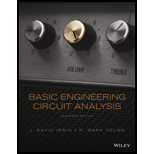
Given
The Period of the current and the Frequency in Hertz.
Answer to Problem 1P
Frequency
Time period
Explanation of Solution
Given Information:
In general,
It is known that
In the given equation of current
Hence,
Although,
Want to see more full solutions like this?
Chapter 8 Solutions
Basic Engineering Circuit Analysis
Additional Engineering Textbook Solutions
Elementary Surveying: An Introduction To Geomatics (15th Edition)
Modern Database Management
Electric Circuits. (11th Edition)
Thinking Like an Engineer: An Active Learning Approach (4th Edition)
Degarmo's Materials And Processes In Manufacturing
Java: An Introduction to Problem Solving and Programming (8th Edition)
- Chapter 14, Problem 15. Construct the Bode magnitude and phase plots for 40(s+1) H(s) (s + 2)(s+10) s=j@arrow_forwardA series RLC network has R = 2 kQ, L = 40 mH, and C = 1 μ F. Calculate the impedance at resonance and at one-fourth, one-half, twice, and four times the resonant frequency.arrow_forwardChapter 14, Problem 5. For each of the circuits shown in Fig. 14.72, find H(s) = V。 (s)/V¸(s). R www V. R L Vo Vs m R (a) www (b) Figure 14.72 For Prob. 14.5. + CV₂arrow_forward
- A robot gripper is shown on Fig.1a. The block diagram of the control system is shown in Fig.1b. This system is conditionally stable because it is stable only for a range of the gain K. Using the Routh-Hurwitz criterion method to determine the range of gain for which the system is stable. Find the steady-state error due to unit step input. Sketch the root locus of the system and analyze its stability. Find the value of K so that the phase margin is minimum, and record the values of the phase margin, gain margin, Mr, and BW. Then draw the Bode plot of the system and discuss its stability using the Nyquist stability method. What is the value of this maximum overshoot for both large and small values of K due to unit step input? Draw the response of the open-loop and closed-loop of the system according to the unit step system for k=15, 25, 50. Discuss how to improve the system response if needed.arrow_forwardPlease show the stepsarrow_forwardDon't use ai to answer I will report you answerarrow_forward
- Derive the transfer functions C'A(s)/T'(s) and T'(s)/C'A0(s). show step by step and write them out so they are easy to read. thank youarrow_forward4) Find the Norton equivalent of the following circuit. 5 µF 4 cos(200t+30°) A ele 10 H www 2 ΚΩ barrow_forwardDon't use ai to answer I will report you answerarrow_forward
- Q1. Consider the unity feedback control system whose open-loop transfer function is: G(s) = = 40(S + 2) s(s+3)(s + 1)(s + 10) hod of Ziegler-Nichols. By using second method of Ziegler- Nichols, calculate the PID, PI-D and I-PD parameters and make tuning for this for this parameters to get accepting response for the following system, then compare your results for all types controllers? GINarrow_forward1) Use the method of source transformation to find Ix in the following circuit. ΖΩ j4Ω wwwm -j20 60/0° V(+ 602 www 492 -j30 wwwarrow_forwardDon't use ai to answer I will report you answerarrow_forward
 Introductory Circuit Analysis (13th Edition)Electrical EngineeringISBN:9780133923605Author:Robert L. BoylestadPublisher:PEARSON
Introductory Circuit Analysis (13th Edition)Electrical EngineeringISBN:9780133923605Author:Robert L. BoylestadPublisher:PEARSON Delmar's Standard Textbook Of ElectricityElectrical EngineeringISBN:9781337900348Author:Stephen L. HermanPublisher:Cengage Learning
Delmar's Standard Textbook Of ElectricityElectrical EngineeringISBN:9781337900348Author:Stephen L. HermanPublisher:Cengage Learning Programmable Logic ControllersElectrical EngineeringISBN:9780073373843Author:Frank D. PetruzellaPublisher:McGraw-Hill Education
Programmable Logic ControllersElectrical EngineeringISBN:9780073373843Author:Frank D. PetruzellaPublisher:McGraw-Hill Education Fundamentals of Electric CircuitsElectrical EngineeringISBN:9780078028229Author:Charles K Alexander, Matthew SadikuPublisher:McGraw-Hill Education
Fundamentals of Electric CircuitsElectrical EngineeringISBN:9780078028229Author:Charles K Alexander, Matthew SadikuPublisher:McGraw-Hill Education Electric Circuits. (11th Edition)Electrical EngineeringISBN:9780134746968Author:James W. Nilsson, Susan RiedelPublisher:PEARSON
Electric Circuits. (11th Edition)Electrical EngineeringISBN:9780134746968Author:James W. Nilsson, Susan RiedelPublisher:PEARSON Engineering ElectromagneticsElectrical EngineeringISBN:9780078028151Author:Hayt, William H. (william Hart), Jr, BUCK, John A.Publisher:Mcgraw-hill Education,
Engineering ElectromagneticsElectrical EngineeringISBN:9780078028151Author:Hayt, William H. (william Hart), Jr, BUCK, John A.Publisher:Mcgraw-hill Education,





